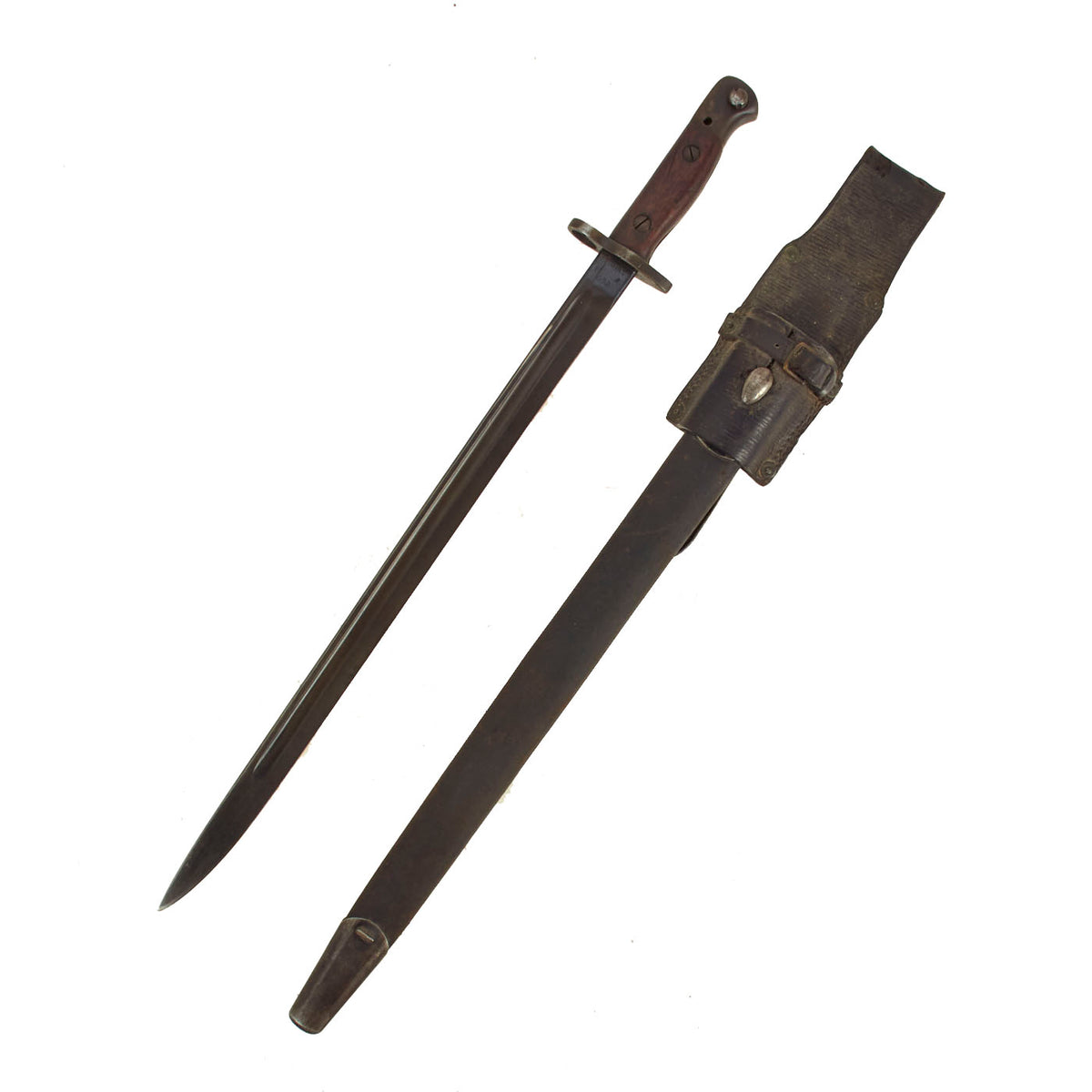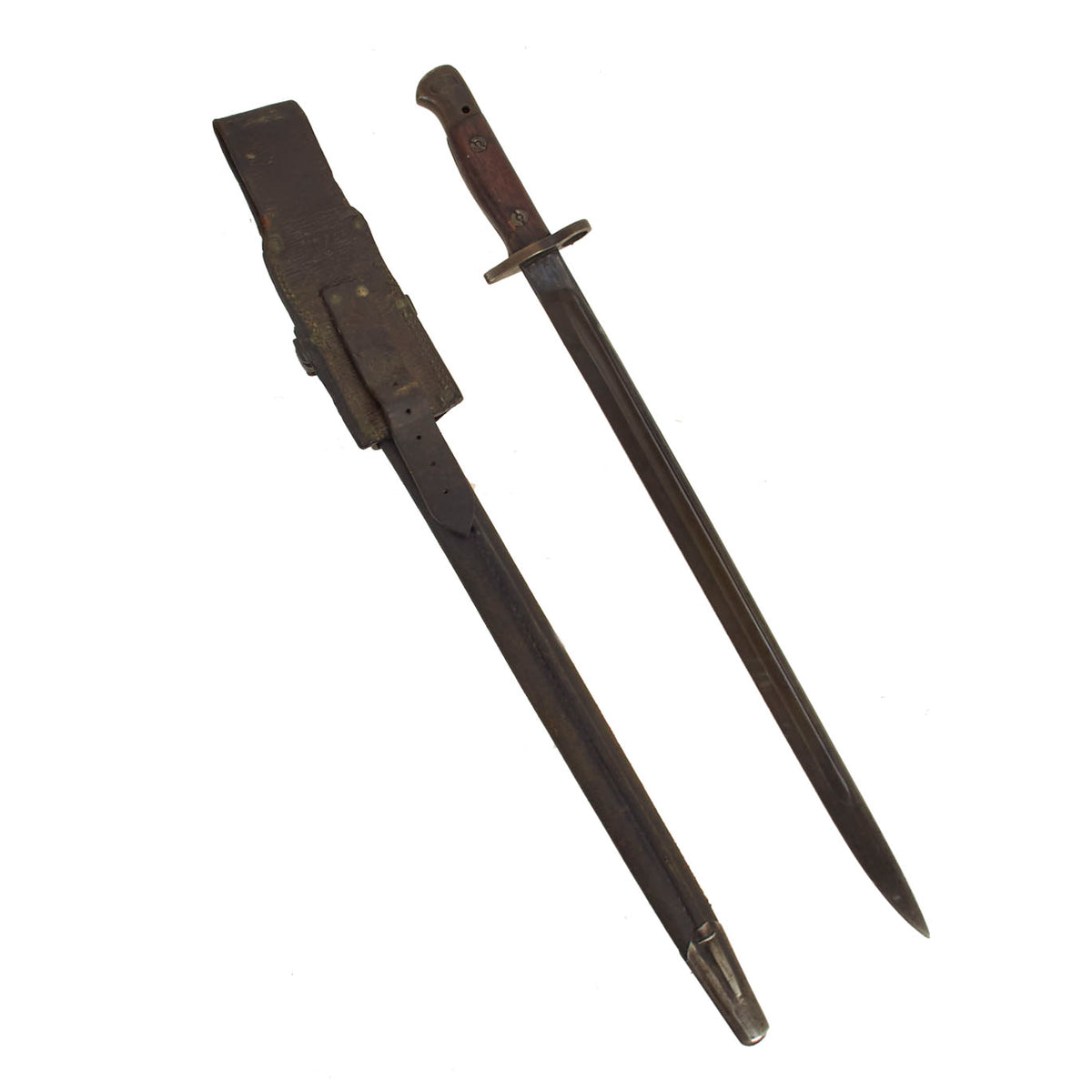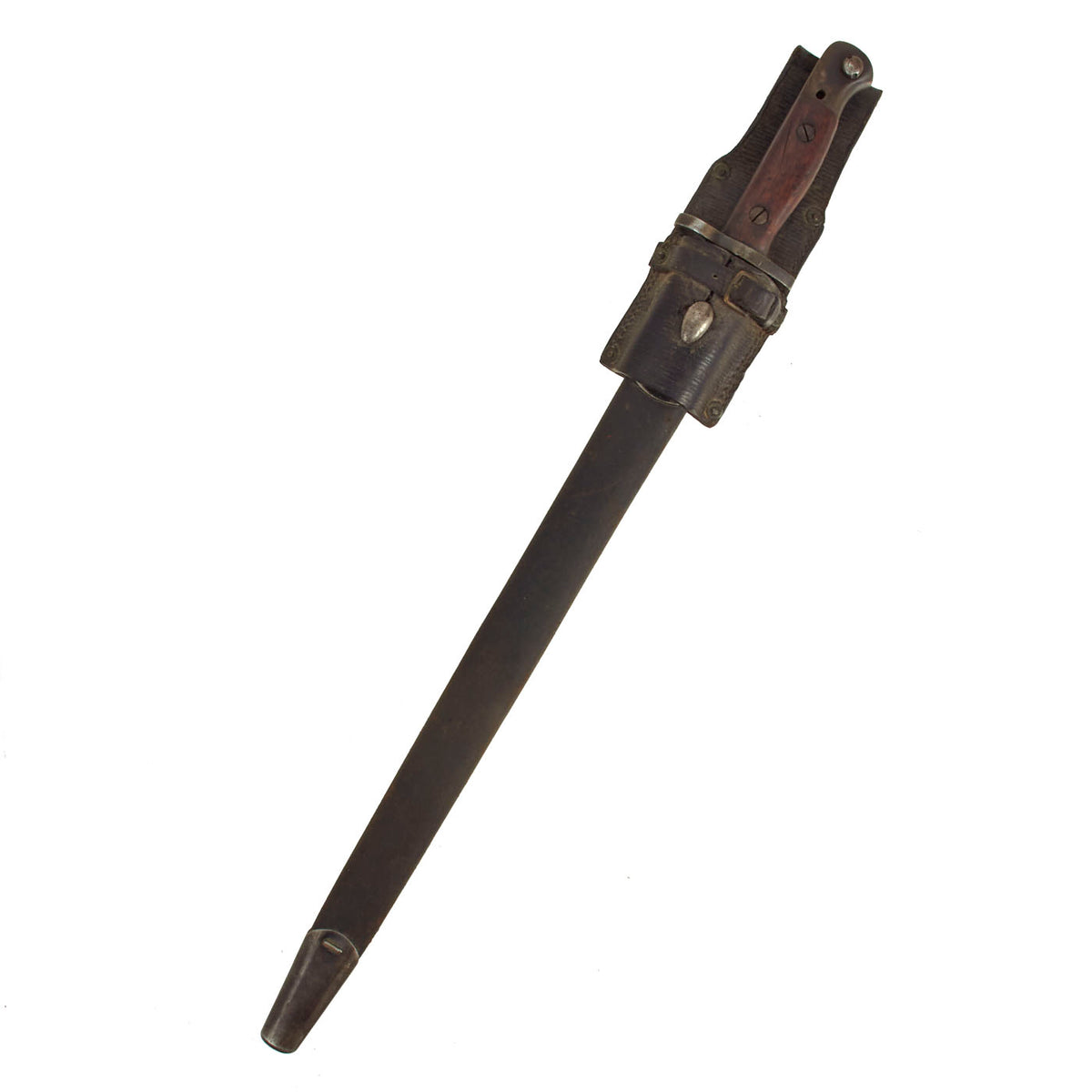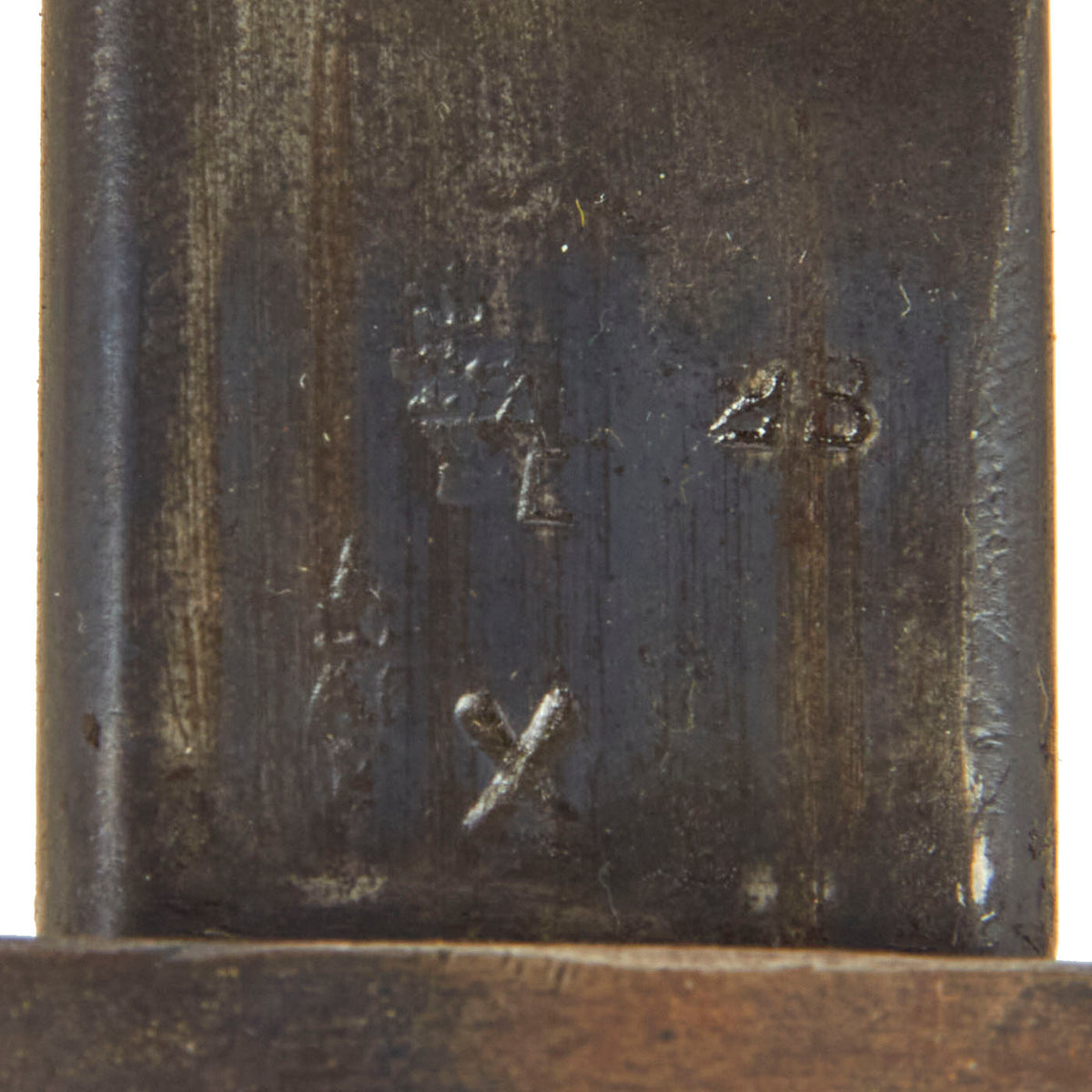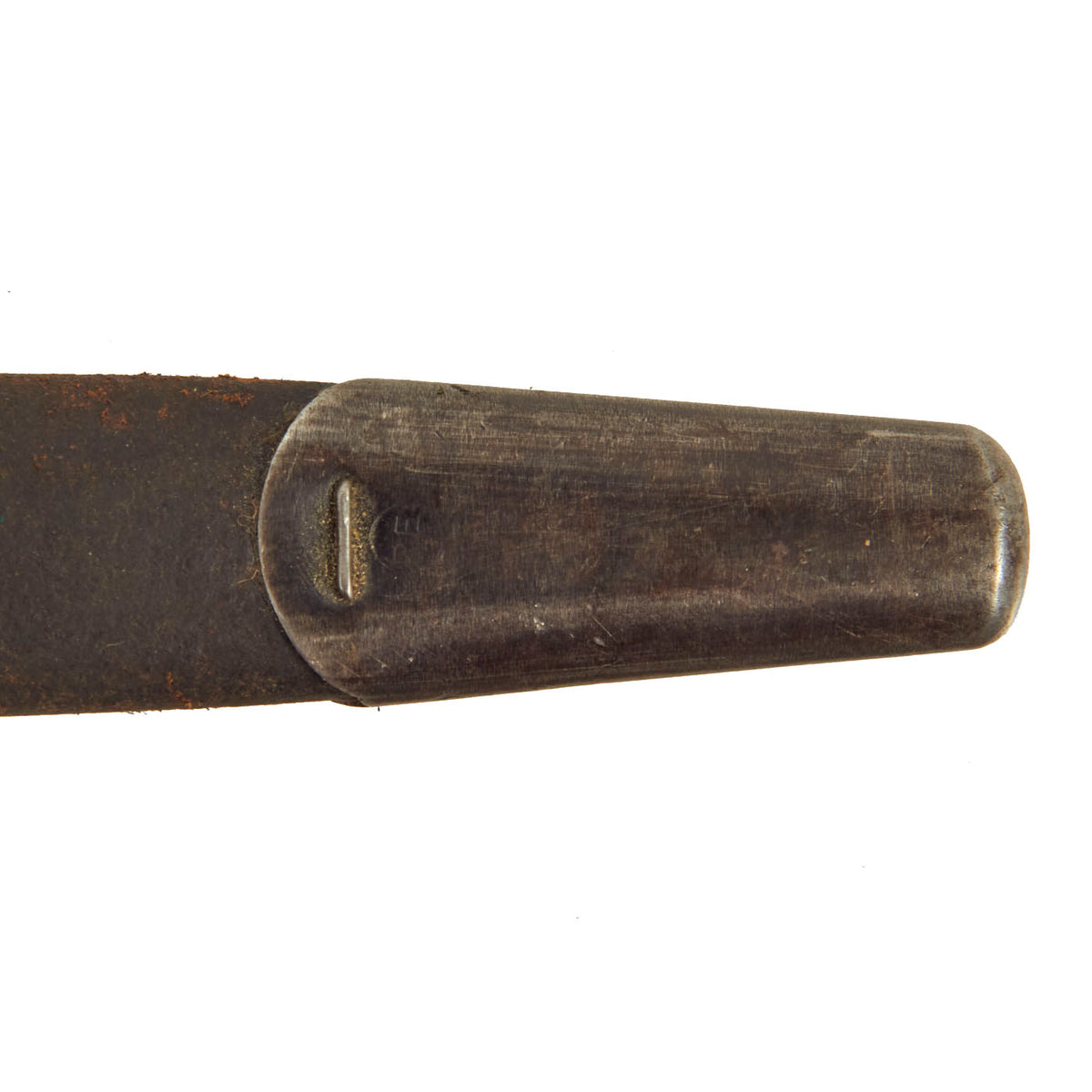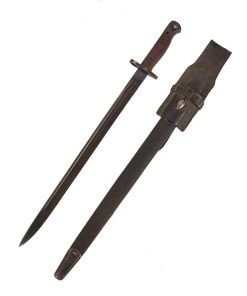Original British WWI P-1907 Enfield Bayonet by WILKINSON with No. I Mk. II Scabbard and P14 Leather Frog – dated 1916 Original Items
$ 250,00 $ 100,00
Original Item: Only One Available. The British “Pattern of 1907” Bayonet was developed for the No.1 MkIII Enfield rifle, often called the SHT.LE, SMLE, S.M.L.E., “Smelly” etc. The P-1907 replaced the earlier P-1903 bayonet, which was a double edged bayonet based on the P-1888 bayonet of the Lee-Metford rifle. The P-1903 had been developed for the “Long” Magazine Lee-Enfield, which was 49.6 inches in overall length. With the introduction of the Short Magazine Lee-Enfield in 1904, the 12 inch bayonet was no longer considered long enough for the 44.6 inch SMLE, so the 17 inch bladed 1907 was developed.
In its original form, the P-1907 had a hooked guard (quillon), which was then removed from the pattern in early WWI due to the questionable use and increased production time. Unlike the 1903, the 1907 had a single edged blade that was less wide, but made of thicker stock.
This is a very nice standard British WWI P-1907 bayonet, which is marked WILKINSON for the famous Wilkinson Sword Company. Above this is the correct “King’s Crown” G.R. over 1907, for a Pattern 1907 bayonet made during the reign of King George V, who reigned 1910 – 1936. This is marked together with all the usual acceptance marks and proofs. The bayonet is also stamped 2 and ’16, indicating manufacture in February of 1916. For more information please see Watts & White THE BAYONET BOOK, Page 393, Item 819.
The bayonet comes with its correct No. I Mk. II Scabbard, with steel fittings and the correct “lozenge” style frog stud. It has the correct three rivets to attach the throat springs, and was not painted green, commonly done when bayonets were reissued for WWII.
The finish on the bayonet crossguard and pommel is still very visible and retained at about 80%. The wood grips are in great condition and only have minor wear to the wood. The scabbard is in excellent condition with no damage or heavy wear to the leather. The steel on both ends are undamaged and still tight to the scabbard.
The scabbard comes with the original P14 black leather frog, complete and without extensive damage. The Pattern 1914 Bayonet frog was introduced with the Infantry Equipment, Pattern 1914 in List of Changes entry L. of C. 16977, dated 30th August 1914. It is designed to carry either the Pattern 1888 or Pattern 1907 Bayonet in scabbard. The 1-inch wide tab at the rear is used to attach the Helve carrier. As with all leather parts of the Pattern 1914 Infantry Equipment, the color was changed from Service Dress to the darker London Brown by List of Changes entry L. of C. 17219, acceptance dates 31 December 1914 and 30 March 1915. The same L. of C. also modified the Frog by adding two additional rivets at each bottom corner.
A very nice British P-1907 bayonet with scabbard, ready to display or fit to your WWI SMLE rifle!
Specifications:
Blade Length: 17″
Blade Style: Single Edge with Fuller
Overall length: 21 3/4″
Crossguard: 2 1/2”
Scabbard Length: 17 1/2″
A bayonet is a knife, dagger, sword, or spike-shaped weapon designed to fit on the end of the muzzle of a rifle, musket or similar firearm, allowing it to be used as a spear-like weapon. From the 17th century to World War I, it was considered a primary weapon for infantry attacks. Today, it is considered an ancillary weapon or a weapon of last resort.
The popular image of World War I combat is of a wave of soldiers with bayonets fixed, “going over the top” and charging across no man’s land into a hail of enemy fire. Although this was the standard method of fighting early in the war, it was rarely successful. British casualties on the first day of the Battle of the Somme were the worst in the history of the British army, with 57,470 British casualties, 19,240 of whom were killed.
During World War I, no man’s land was often hundreds of yards across. The area was usually devastated by the warfare and riddled with craters from artillery and mortar shells, and sometimes contaminated by chemical weapons. Heavily defended by machine guns, mortars, artillery and riflemen on both sides, it was often covered with barbed wire and land mines, and littered with the rotting corpses of those who were not able to make it across the sea of bullets, explosions and flames. A bayonet charge through no man’s land often resulted in the total annihilation of entire battalions.
Fast Shipping with Professional Packaging
Thanks to our longstanding association with UPS FedEx DHL, and other major international carriers, we are able to provide a range of shipping options. Our warehouse staff is expertly trained and will wrap your products according to our exact and precise specifications. Prior to shipping, your goods will be thoroughly examined and securely secured. We ship to thousands clients each day across multiple countries. This shows how we're dedicated to be the largest retailer on the internet. Warehouses and distribution centres can be located throughout Europe as well as the USA.
Note: Orders with more than one item will be assigned a processing date depending on the item.
Before shipping before shipping, we'll conduct a thorough inspection of the items you have ordered. Today, the majority of orders will be delivered within 48 hours. The delivery time will be between 3-7 days.
Returns
The stock is dynamic and we cannot completely manage it because multiple stakeholders are involved, including our factory and warehouse. So the actual stock may alter at any time. It's possible that you may not receive your order once the order has been made.
Our policy is valid for a period of 30 days. If you don't receive the product within 30 days, we are not able to issue a refund or an exchange.
You can only return an item if it is unused and in the same state as the day you received it. You must have the item in its original packaging.
Related products
Uncategorized
Uncategorized
Uncategorized
Uncategorized
Uncategorized
Uncategorized
Australian WWII Owen MK1 Machine Carbine SMG Custom Fabricated Replica with Sling Original Items
Uncategorized
Uncategorized
Uncategorized
Uncategorized
Armored Burgonet Helmet & Polearm from Scottish Castle Leith Hall Circa 1700 Original Items
Uncategorized
Uncategorized
Angolan Rebel 1970s era 60mm Inert Display Mortar from Angolan Civil War Original Items
Uncategorized
Uncategorized
Uncategorized
Uncategorized
Uncategorized
